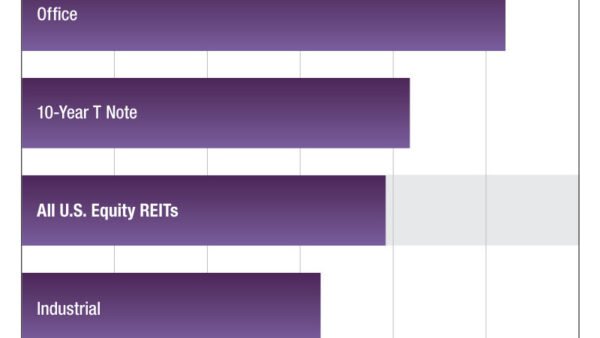The announcement last Friday that 99 Cents Only Stores LLC was going out of business has immediately put into play the company’s 44 owned and 333 leased locations in Arizona, California, Nevada and Texas.

In this era of retail turmoil, the questions for the real estate industry are at least fairly predictable: How quickly are those spaces likely to be acquired? By whom? And how is the dollar store sector doing in a time of booming job growth coupled with substantial inflation anxiety?
Overall, retail sector observers are moderately optimistic that these 300-plus locations will be in demand.
“There is a strong likelihood that the spaces could be backfilled quickly. The average size of the 99 Cents Only stores is around 21,000 square feet, which is a good junior anchor box size that many retailers looking to expand in the U.S. seek,” Brandon Isner, CBRE’s Americas head of retail research, told Commercial Property Executive.
Of course, it’s more complicated than that, as Isner acknowledges: “Location is everything. Many retailers use focused location analytics to determine where their expansion strategies should be aimed. Often, they’ll seek out the best submarkets and trade areas first, so the 99 Cent Only stores in growing markets will be the first to be backfilled.”
READ ALSO: As Grocers Grow Faster, Investor Interest Heats Up
He notes that, just by themselves, the four states where these properties are located represent about 25 percent of U.S. consumer spending. Even though California reportedly is losing population, “with an estimated $2.4 trillion in consumer spending in 2023, it remains far and away the state with the highest level of consumer spending, with Texas in second place with an estimate of over $1.4 trillion,” Isner told CPE, citing data from Oxford Economics.
Isner added that nationally, retail remains at a record-low level of availability, just 4.7 percent across the markets that CBRE tracks.

Also invoking property locations and fundamentals, Chris Wilson, JLL National Agency lead, Retail, estimates that about 60 percent of the 99 Cents Only stores will attract enough interest to lease quickly. Beyond those, he commented for CPE, “Twenty-five percent of the stores will have development interest for adaptive reuse to multifamily, mixed-use or a ground lease. The final 15 percent might have trouble getting interest.”
In general, he added, “Demand for stores in this size range is excellent. The supply imbalance for the past three years coupled with the strong consumer economy and tenant demand makes these buildings and land they sit on very attractive and valuable.”
Chris Premac, senior associate of retail brokerage for Coreland Cos., Tustin, Calif., elaborated on some further nuances: “Like many real estate portfolios, 99 Cents Only has high-end and low-end locations. Some key vacancies will provide landlords with a strong opportunity to re-lease the space and upgrade rents and tenancies,” he told CPE.
“Other, less-desirable locations will create more of a problem for owners,” he continued, “as they might sit vacant or go backwards in rent. Unfortunately, we might be dealing with more of the latter, as 99 Cents Only has been working to strategically re-tenant its best real estate for several months now.”
Likely suitors
As to which types of chain retailers might be in the market for 99 Cents Only locations, Isner stated: “Discount retailers have been known to backfill spaces within that range. Additionally, smaller-format grocery stores have backfilled a few boxes around that size, so they could potentially be in the mix.”

In addition, he remarked, some department stores have been closing underperforming full-size locations and looking for smaller, off-mall locations for expansion in 2024 and beyond. Isner adds to this list of interested parties other off-price retailers and discount department stores and certain grocery stores, this last type “especially in spaces where they don’t already have a presence.”
Wilson predicts that smaller-format grocery, soft goods, discount, food, drive-thru and retailers will be interested in these sites.
Premac reports that Coreland has been working with “several expanding users targeting Southern California locations in the 15,000- to 20,000-square-foot range. Aldi, Grocery Outlet, Trader Joe’s and Ace Hardware, to name a few, all pursued the similarly sized Big Lots portfolio that was on the market last year.”
The overall health of dollar stores
And our last question, whether—99 Cents Only notwithstanding—the dollar store category remains healthy, is answered mostly in the affirmative.
“It is true that dollar stores do well in downturns, and I believe that their overall sales have increased over the last few years, as a result of higher traffic and increased pricing strategies that most have deployed,” said Wilson.
READ ALSO: Is Retail 2024’s Sleeper Hit?
He added, however, “The primary challenges on profitability/margins are many, though. Costs have gone up across the board. This includes costs around shipping, materials, labor, security, construction (which impacts new store growth and renovations) and rising real estate operational and management costs (like insurance, utilities, shopping center maintenance, real estate taxes). While dollar stores operate within every socio-economic community, they have a higher concentration in urban areas, which often results in higher levels of shrink/theft, which further impacts profitability.”

Lea Clay Park of Axiom Retail Advisors, Irvine, Calif., told CPE, “99 Cents Only’s demise is not surprising. They simply could not compete on scale with other players in the field who enjoy exponentially larger scale and are better able to drive down COGS in this inflationary environment. Produce was their key differentiator, and several discount grocers such as Aldi and Grocery Outlet have encroached on that space in recent years.”
Park, who is also executive director of X Team Retail Advisors, added, “The good news is that most of the locations are well located, sized and serviced, and they should be absorbed rather quickly. The market has planned for this.”
Premac commented that “Overall, the dollar store market continues to be strong, with Placer.ai noting a 7.1 percent increase in foot traffic year-over-year. However, there are winners and losers in any segment of the industry, Dollar General and Dollar Tree accounting for the increase, while 99 Cents Only and Family Dollar announcing 1,000-plus store closures coming this year and upon lease expirations.”
It’s widely expected, he added, that 99 Cents Only’s and Family Dollar’s losses will be gains for Walmart, Grocery Outlet, Aldi and other discount operators.
“There will always be a place for budget-minded or discount retailers,” Isner reminds us.
He reports that the default risk of retailers declined from 2.3 percent to 2.0 percent from February to March, according to data from S&P Global Market Intelligence.
“Retail bankruptcies happen,” he commented, “but as of yet, there hasn’t been a considerable rise in them when comparing the previous 10 years, on a year-to-date basis. With dollar stores, one of the primary issues is saturation, which could be eased by this news and the news of Family Dollar. That said, companies like Dollar Tree and Dollar General remain solid.”





